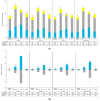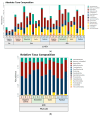Effects of NatureKnit™, a Blend of Fruit and Vegetable Fibers Rich in Naturally Occurring Bound Polyphenols, on the Metabolic Activity and Community Composition of the Human Gut Microbiome Using the M-SHIME® Gastrointestinal Model
- PMID: 40142506
- PMCID: PMC11944907
- DOI: 10.3390/microorganisms13030613
Effects of NatureKnit™, a Blend of Fruit and Vegetable Fibers Rich in Naturally Occurring Bound Polyphenols, on the Metabolic Activity and Community Composition of the Human Gut Microbiome Using the M-SHIME® Gastrointestinal Model
Abstract
This study evaluated the impact of a proprietary blend of fruit and vegetable fibers rich in naturally occurring bound polyphenols (commercially marketed as NatureKnitTM), compared to purified fibers (inulin and psyllium), on the human gut microbiome using the validated M-SHIME® gastrointestinal model. A short-term single-stage colonic M-SHIME® experiment (with fecal inoculum from three healthy human donors) was used to evaluate the test products compared to a negative control. Samples were assessed for pH, gas pressure, short-chain fatty acid (SCFA) production, lactate, and ammonium from 0 h to 48 h. Microbial community composition was assessed at 0 h (negative control only), 24 h, and 48 h (lumen) or 48 h (mucosal). All test products were fermented well in the colon as demonstrated by decreases in pH and increases in gas pressure over time; these changes occurred faster with the purified fibers, whereas NatureKnit™ demonstrated slow, steady changes, potentially indicating a gentler fermentation process. SCFA production significantly increased over the course of the 48 h experiment with all test products versus negative control. SCFA production was significantly greater with NatureKnit™ versus the purified fibers. Shifts in the microbial community composition were observed with all test products versus negative control. At the conclusion of the 48 h experiment, the absolute bacterial abundance and the richness of observed bacterial taxa in the lumen compartment was significantly greater with NatureKnit™ compared with inulin, psyllium, and negative control. Overall, NatureKnit™ demonstrated greater or similar prebiotic effects on study measures compared with established prebiotic fibers.
Keywords: Mucosal Simulator of the Human Intestinal Microbial Ecosystem (M-SHIME®); bound polyphenols; fiber; gut microbiome; inulin; polyphenol; prebiotic; psyllium; short-chain fatty acid (SCFA).
Conflict of interest statement
Brendan Kesler is an employee of VDF FutureCeuticals, Inc. Marlies Govaert; Cindy Duysburgh and Massimo Marzorati are employees of ProDigest. The funder had no role in the final study design, data collection, analysis, nor the interpretation of results.
Figures






References
-
- Dietary Guidelines for Americans 2020–2025. [(accessed on 30 August 2024)]; Available online: https://www.dietaryguidelines.gov/sites/default/files/2021-03/Dietary_Gu....
-
- Stephen A.M., Champ M.M., Cloran S.J., Fleith M., van Lieshout L., Mejborn H., Burley V.J. Dietary fibre in Europe: Current state of knowledge on definitions, sources, recommendations, intakes and relationships to health. Nutr. Res. Rev. 2017;30:149–190. doi: 10.1017/S095442241700004X. - DOI - PubMed
Grants and funding
LinkOut - more resources
Full Text Sources

